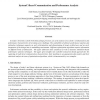Free Online Productivity Tools
i2Speak
i2Symbol
i2OCR
iTex2Img
iWeb2Print
iWeb2Shot
i2Type
iPdf2Split
iPdf2Merge
i2Bopomofo
i2Arabic
i2Style
i2Image
i2PDF
iLatex2Rtf
Sci2ools
89
Voted
FDL
2005
IEEE
2005
IEEE
SystemC-Based Communication and Performance Analysis
In today’s electronic system-level (ESL) design processes, an early analysis of a system’s communication and nce characteristics is becoming a key challenge. The availability of abstract performance analysis and estimation techniques supports an early determination and dimensioning of target architectures and an early integration of the design into its embedding environment. Different optimization algorithms require information rent levels of abstraction. The paper addresses static analytical as well as dynamic simulation-based performance analysis techniques. The paper gives insights into a flexible transaction-based approach for the capturing of multi-level communication characteristics, their matching to an appropriate data model, and their statistical analysis in terms of optimization algorithms, which is demonstrated by two examples.
Related Content
| Added | 24 Jun 2010 |
| Updated | 24 Jun 2010 |
| Type | Conference |
| Year | 2005 |
| Where | FDL |
| Authors | Axel G. Braun, Joachim Gerlach, Wolfgang Rosenstiel, Axel Siebenborn, Oliver Bringmann |
Comments (0)

